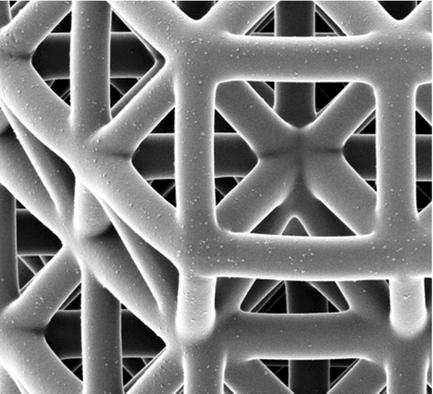当前位置:
X-MOL 学术
›
Adv. Mater.
›
论文详情
Our official English website, www.x-mol.net, welcomes your
feedback! (Note: you will need to create a separate account there.)
Nanolattices: An Emerging Class of Mechanical Metamaterials
Advanced Materials ( IF 27.4 ) Pub Date : 2017-09-05 , DOI: 10.1002/adma.201701850 Jens Bauer 1, 2 , Lucas R. Meza 3 , Tobias A. Schaedler 4 , Ruth Schwaiger 2 , Xiaoyu Zheng 5 , Lorenzo Valdevit 1
Advanced Materials ( IF 27.4 ) Pub Date : 2017-09-05 , DOI: 10.1002/adma.201701850 Jens Bauer 1, 2 , Lucas R. Meza 3 , Tobias A. Schaedler 4 , Ruth Schwaiger 2 , Xiaoyu Zheng 5 , Lorenzo Valdevit 1
Affiliation

|
In 1903, Alexander Graham Bell developed a design principle to generate lightweight, mechanically robust lattice structures based on triangular cells; this has since found broad application in lightweight design. Over one hundred years later, the same principle is being used in the fabrication of nanolattice materials, namely lattice structures composed of nanoscale constituents. Taking advantage of the size‐dependent properties typical of nanoparticles, nanowires, and thin films, nanolattices redefine the limits of the accessible material‐property space throughout different disciplines. Herein, the exceptional mechanical performance of nanolattices, including their ultrahigh strength, damage tolerance, and stiffness, are reviewed, and their potential for multifunctional applications beyond mechanics is examined. The efficient integration of architecture and size‐affected properties is key to further develop nanolattices. The introduction of a hierarchical architecture is an effective tool in enhancing mechanical properties, and the eventual goal of nanolattice design may be to replicate the intricate hierarchies and functionalities observed in biological materials. Additive manufacturing and self‐assembly techniques enable lattice design at the nanoscale; the scaling‐up of nanolattice fabrication is currently the major challenge to their widespread use in technological applications.
中文翻译:

纳米晶格:一类新兴的机械超材料
1903年,亚历山大·格雷厄姆·贝尔(Alexander Graham Bell)提出了一种设计原理,以基于三角形单元生成轻巧,机械坚固的晶格结构。此后在轻量级设计中得到了广泛的应用。一百多年后,纳米晶格材料的制造中使用了相同的原理,即由纳米级成分组成的晶格结构。利用纳米颗粒,纳米线和薄膜通常具有的尺寸依赖性,纳米晶格重新定义了不同学科中可访问的材料-属性空间的限制。在此,对纳米晶格的出色机械性能(包括其超高强度,损伤耐受性和刚度)进行了综述,并研究了其在力学之外的多功能应用领域的潜力。结构和受尺寸影响的属性的有效集成是进一步开发纳米晶格的关键。引入分层体系结构是增强机械性能的有效工具,纳米晶格设计的最终目标可能是复制在生物材料中观察到的复杂层次结构和功能。增材制造和自组装技术可实现纳米级的晶格设计。目前,纳米晶格制造的规模化是其在技术应用中广泛使用的主要挑战。纳米晶格设计的最终目标可能是复制在生物材料中观察到的复杂的层次结构和功能。增材制造和自组装技术可实现纳米级的晶格设计。目前,纳米晶格制造的规模化是其在技术应用中广泛使用的主要挑战。纳米晶格设计的最终目标可能是复制在生物材料中观察到的复杂的层次结构和功能。增材制造和自组装技术可实现纳米级的晶格设计。目前,纳米晶格制造的规模化是其在技术应用中广泛使用的主要挑战。
更新日期:2017-09-05
中文翻译:

纳米晶格:一类新兴的机械超材料
1903年,亚历山大·格雷厄姆·贝尔(Alexander Graham Bell)提出了一种设计原理,以基于三角形单元生成轻巧,机械坚固的晶格结构。此后在轻量级设计中得到了广泛的应用。一百多年后,纳米晶格材料的制造中使用了相同的原理,即由纳米级成分组成的晶格结构。利用纳米颗粒,纳米线和薄膜通常具有的尺寸依赖性,纳米晶格重新定义了不同学科中可访问的材料-属性空间的限制。在此,对纳米晶格的出色机械性能(包括其超高强度,损伤耐受性和刚度)进行了综述,并研究了其在力学之外的多功能应用领域的潜力。结构和受尺寸影响的属性的有效集成是进一步开发纳米晶格的关键。引入分层体系结构是增强机械性能的有效工具,纳米晶格设计的最终目标可能是复制在生物材料中观察到的复杂层次结构和功能。增材制造和自组装技术可实现纳米级的晶格设计。目前,纳米晶格制造的规模化是其在技术应用中广泛使用的主要挑战。纳米晶格设计的最终目标可能是复制在生物材料中观察到的复杂的层次结构和功能。增材制造和自组装技术可实现纳米级的晶格设计。目前,纳米晶格制造的规模化是其在技术应用中广泛使用的主要挑战。纳米晶格设计的最终目标可能是复制在生物材料中观察到的复杂的层次结构和功能。增材制造和自组装技术可实现纳米级的晶格设计。目前,纳米晶格制造的规模化是其在技术应用中广泛使用的主要挑战。











































 京公网安备 11010802027423号
京公网安备 11010802027423号